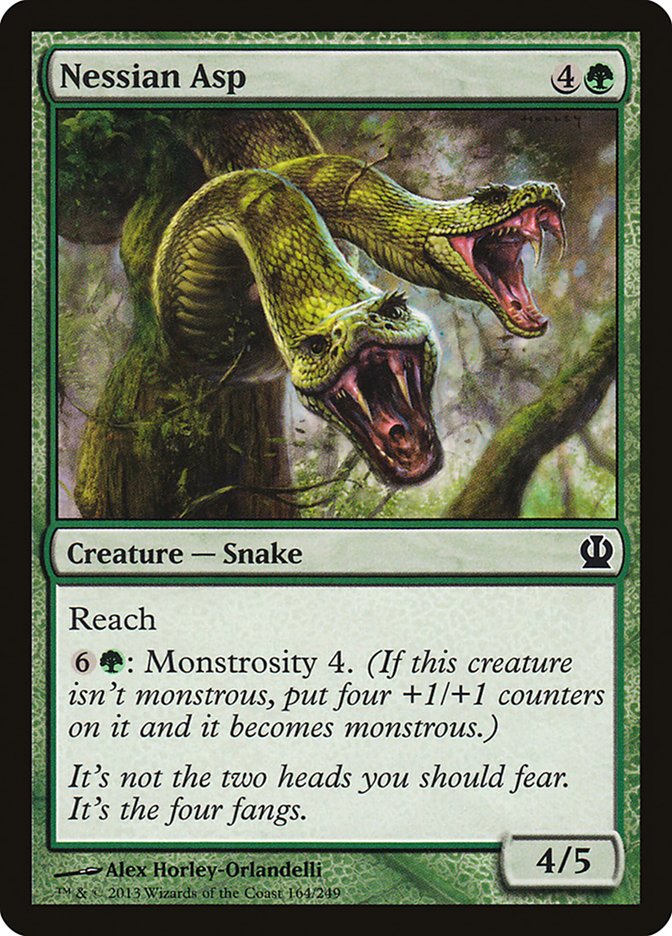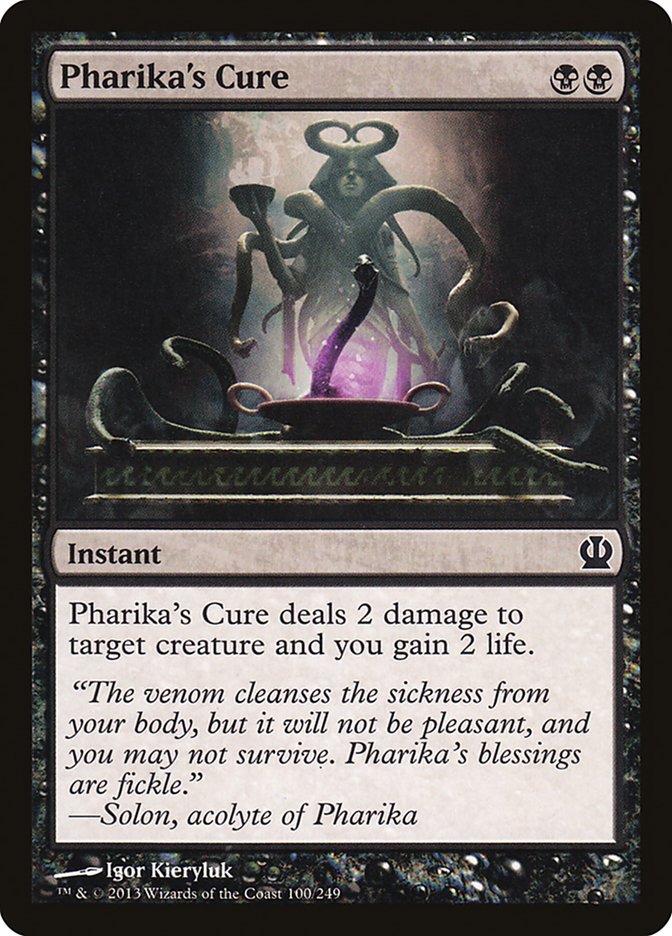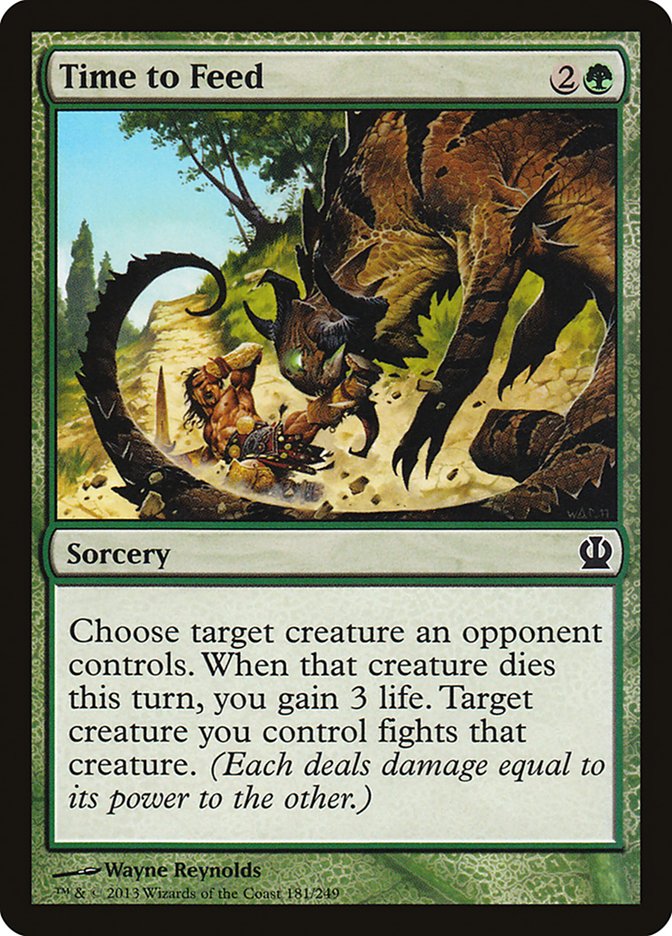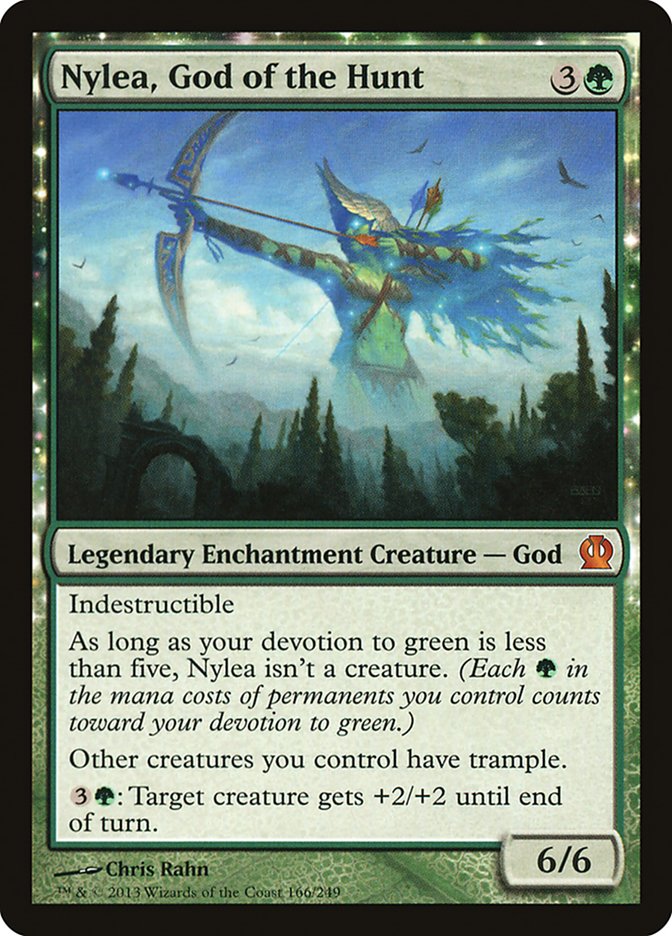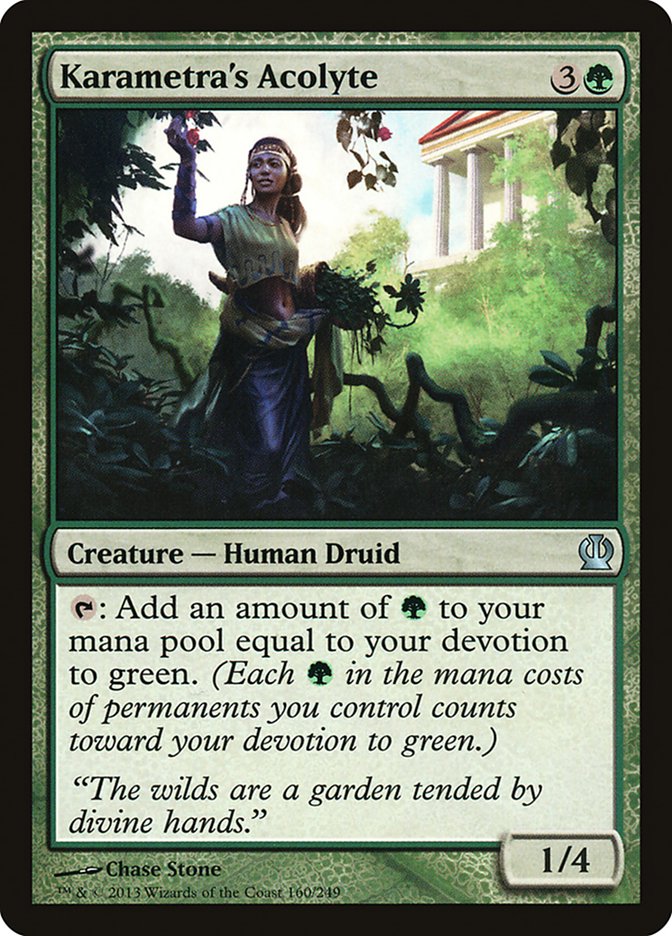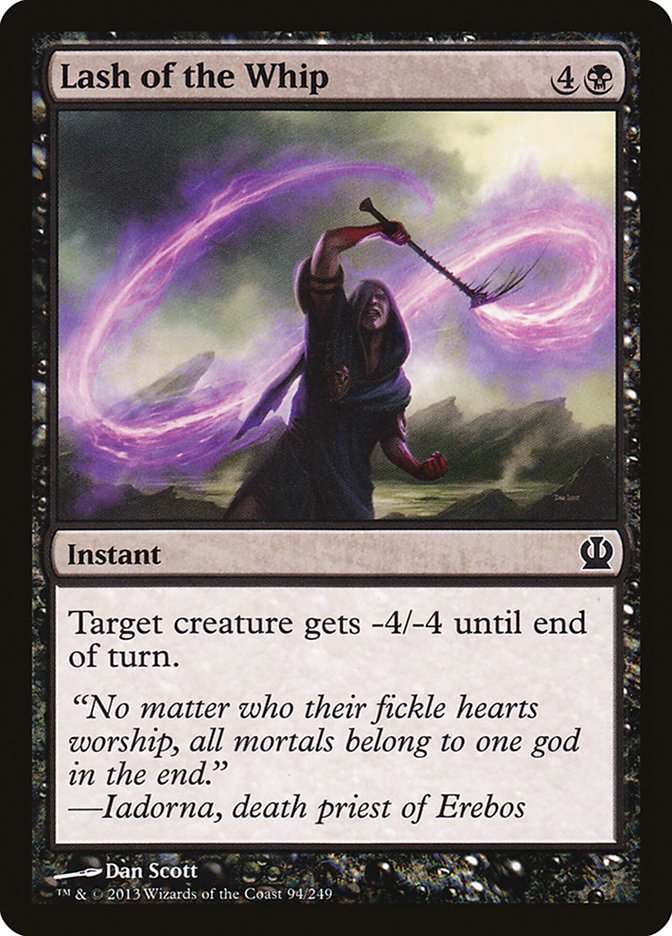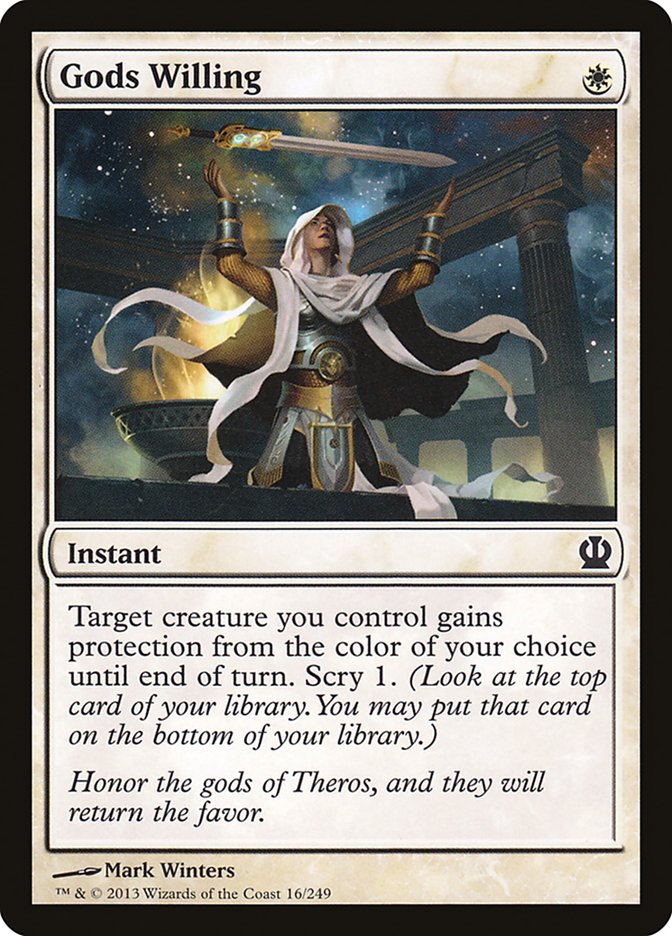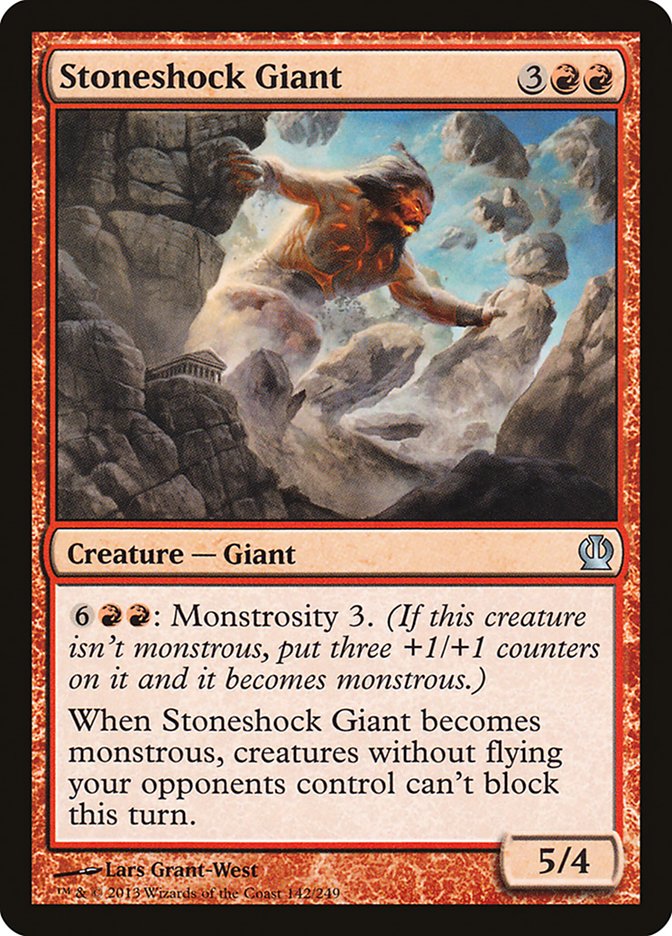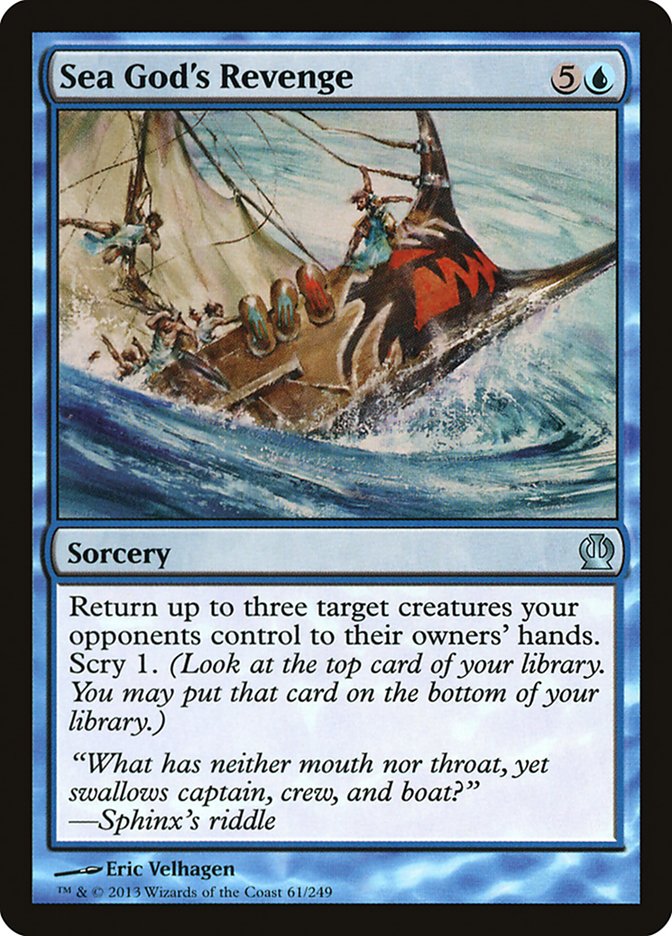If you’re anything like me, you’ll agree that playing Magic is one of the best things in the world. Whether it’s at a Pro Tour, Friday Night Magic or even just the kitchen counter, I’m always down to sling some cards. It’s no surprise that this past weekend I found myself with fellow degens Joe Demestrio, Alec Nezin, and Dom Nasta heading down to Empire Gaming in Long Island to play in the midnight Theros Prerelease.
Going into the event I didn’t have too many preconceived notions about how the format would play out. A quick glance over the spoiler showed a lot of combat tricks and a few mana sinks in the form of monstrosity and bestow. Since I didn’t bother to find out what any of the promo cards were,* I had no choice but to audible to my favorite color: black. This is the pool I opened:
Green
Warriors’ Lesson x2
Hunt the Hunter
Leafcrown Dryad x2
Commune with the Gods
Nylea’s Presence
Agent of Horizons
Time to Feed x 2
Fade Into Antiquity
Shredding Winds
Karametra’s Acolyte
Nylea, God of the Hunt
Nylea’s Disciple
Polukranos, World Eater
Centaur Battlemaster
Arbor Colossus
Pheres-Band Centaurs
Nemesis of Mortals
Vulpine Goliath x2
Black
Asphodel Wanderer
Viper’s Kiss
Scourgemark x2
Baleful Eidolon
Pharika’s Cure
Nighthowler
Erebos’s Emissary
Disciple of Phenax
Cavern Lampad
March of the Returned
Keepsake Gorgon
Lash of the Whip x3
Sip of Hemlock
Abhorrent Overlord
White
Traveling Philosopher
Ordeal of Heliod
Chosen by Heliod x3
Wingsteed Rider x2
Lagonna-Band Elder
Scholar of Athreos
Observant Alseid
Ray of Dissolution x2
Silent Artisan
Setessan Griffin
Evangel of Heliod
Red
Satyr Rambler
Two-Headed Cerberus x2
Minotaur Skullcleaver x3
Ill-Tempered Cyclops
Ember Swallower
Purphoros’s Emissary
Fanatic of Mogis
Portent of Betrayal
Wild Celebrants x2
Rage of Purphoros
Boulderfall
Blue
Annul
Lost in a Labyrinth
Vaporkin
Ordeal of Thassa
Stymied Hopes
Nimbus Naiad x2
Triton Fortune Hunter
Sealock Monster
Mnemonic Wall
Thassa’s Bounty
Multicolored
Triad of Fates
Kragma Warcaller
Pharika’s Mender
Artifact
Traveler’s Amulet
Prowler’s Helm
Opaline Unicorn
The first thing I noticed as I sorted out my pool was the quality of my green rares. Arbor Colossus and Polukranos, World Eater are both very powerful cards. I wasn’t too sure what to think of Nylea, God of the Hunt but I definitely wanted to try it out. In Sealed the format tends to be slower, so powerful bomb rares have a very high chance of taking over the game. I knew early on that as long as the green was remotely deep I’d be playing it.
Finding a second color to work with was a bit tougher. I liked the aggressive fliers in blue, but the color overall wasn’t as deep as I would have liked and there were a few holes in the curve. Although red was very aggressive and had powerful cards like Ember Swallower and Purphoros’s Emissary, I felt like it was a little too scrappy and that it didn’t have enough early rush potential to beat people playing more powerful cards. Other than Evangel of Heliod, white didn’t have much going for it at all.
Without too much to draw me to the other options, I was left with my chosen color of black. Abhorrent Overlord provided another bomb rare, and although it’s a little slow, it came equipped with a good removal suite. Two of the biggest draws to black were Pharika’s Cure and Baleful Eidolon. I knew my deck was going to be slow and a little clunky, so having two two-mana answers to early aggression was very appealing. Baleful Eidolon looked especially awesome with how well its bestow paired with the trample on Nylea and the monstrosity on Polukranos. All in all, I wanted to have a Rock style deck that stalled out the game with removal until my giant creatures could take it down.
After swapping around a few configurations, here is the deck I sleeved up somewhere around 12:30 AM:
Creatures (16)
- 1 Polukranos, World Eater
- 1 Abhorrent Overlord
- 1 Nylea, God of the Hunt
- 1 Karametra's Acolyte
- 1 Nighthowler
- 2 Leafcrown Dryad
- 1 Arbor Colossus
- 1 Keepsake Gorgon
- 1 Centaur Battlemaster
- 1 Baleful Eidolon
- 1 Disciple of Phenax
- 1 Nylea's Disciple
- 1 Opaline Unicorn
- 1 Nemesis of Mortals
- 1 Pharika's Mender
Lands (17)
Spells (7)

As I expected, it ended up being a little on the slower side but packed a helluva punch. Although a three-mana 1/2 might not be the best body, I was very happy to have Opaline Unicorn along for the ride to help fix my mana and accelerate out some of my creatures. One of my biggest decisions (and one I made incorrectly) was whether to play Commune with the Gods or an eighteenth land. My logic at the time was it would be a great way to dig to my bombs as well as provide incidental value for Nighthowler and Nemesis of Mortals.
However, my deck was already so universally strong that one of the few ways I could lose was not hitting my land drops on time. Also, because Commune does not give you the option to take a land, it ended up at best adding one or two creatures to my graveyard when I played it, which really isn’t that big of a deal. Although I think the card is good, this deck definitely would have been better off with another mana source.
I ended up going 3-2 with the deck and lost more than one game due to mana issues. Although I didn’t earn myself any prize, I had a lot of fun and I feel like I learned a lot about the basics of the format. Probably the biggest thing I learned is just how choked on mana a deck can be. Between monstrosity and bestow, there really are tons of ways to spend your mana that don’t actually involve expending actual cards. Because of this it felt like games didn’t really come down to card advantage as much as efficient mana usage. Regularly both my opponent and I had a full grip of cards with multiple potentially monstrous creatures on the battlefield and just threw haymakers at each other.
Tempo was very important; usually, if a player could establish a board presence and start using their mana sinks first, it was very hard to come back from. Cards like Voyage’s End ended up being very powerful. Think about using it on a post-monstrous Nessian Asp. You just traded two mana for your opponents twelve-mana investment! That’s about as big of a tempo swing as you can get.
Throughout the tournament, I chose to draw whenever I had the decision. The format didn’t look like it was going to be very fast, and I figured being up a card would be very important. Although I was correct in that I didn’t meet my demise at the hands of any early rushes, I’m not sure if being on the draw is correct moving forward. As I said, tempo is a very defining aspect of how the games play out. Having your creatures in play first means getting to use monstrosity and bestow first and keeping your opponent on the back foot. Running out of things to spend your mana on isn’t really an issue, so having the extra card might not be nearly as important as it usually would. The biggest appeal to drawing is going to be making sure you have every chance to hit land drops. I suspect I’m going to have to jam some more games before I’m sure which route is 100% correct.
I would definitely say that this set has a very unique feel to it. There were a few cards that really surprised me with how they performed either from my own deck or out of my opponent’s. Let’s take a look at some of them now starting with the cards from my deck.
As I mentioned before, this card was one of the key reasons I wanted to go into black. I figured stemming early aggression while gaining some life would be huge. As it turned out, I found it stuck in my hand without a good target on more than one occasion. When a majority of the creatures in the format are huge or bigger because of bestow, it becomes harder to get full value off of a card like Pharika’s Cure. Although I don’t regret maindecking it, I sided it out almost every match in favor of more impactful cards.
Another card that looks killer at first glance. How could you go wrong with a Prey Upon that also gains life? Unfortunately, the difference between one and three mana is even more pronounced in this set than others. On top of that, there are a lot of combat tricks that can really punish you for going for the fight when your opponent has mana up. I did end up playing one in my deck because of just how large my creatures were, and it was passable. Time to Feed will be at its best as a heroic enabler. The times I used in conjunction with my Centaur Battlemaster were awesome.
I’m going to go out on a limb here and say the Gods might be actively bad in Limited. Getting devotion was even harder than I expected and never really happened unless I had Arbor Colossus out. As I said, mana usage is stretched very thin, so having another way to dump mana isn’t that rewarding. When you’re behind, playing them basically does nothing. Alec had Heliod in his deck and at the end of the night frustratingly referred to it as a worse Centaur Glade.
Now here’s a card that blew my expectations out of the water. To be honest, it almost didn’t even make the cut for my deck, which would have been the biggest mistake of my night. The card snowballs out of control extremely fast. First, it allows you to power out giant creatures and makes more and more mana as you go. Once you’ve vomited your hand onto the board, you can easily add six or seven mana in one tap and make your creatures monstrous very quickly. Take this sequence of plays for example:
Turn 2: Play Leafcrown Dryad.
Turn 4: Play Karametra’s Acolyte.
Turn 5: Play Polukranos. Tap Acolyte for four green. Play Nylea, God of the Hunt.
Turn 6: Monstrosity Polukranos for approximately one billion
The fact that this card is a reasonable blocker is strictly a bonus, as I’d gladly play it as a four-mana 1/1.
Next to Nylea this was the card I was most disappointed with. When I pay five mana for a removal spell, I expect to be able to kill something. A lot of the important creatures were just too big to make Lash of the Whip good, especially once they were bestowed. Leveraging it as a combat trick is extremely awkward and obvious. I was much more impressed with Sip of Hemlock and am glad I didn’t play the third.
I’m always a huge fan of one-mana interaction, as it is very good at maximizing your mana. In a tempo-oriented set, spending the minimal amount to not get blown out by a bounce or removal spell on your huge monster is going to be as good as it gets. Getting some scry value doesn’t hurt either.
Even though the creatures in this set are pretty huge in general, you can’t go wrong with a five-mana 5/4. This card really shines once you take its monstrosity ability into account. One way to negate tempo from mattering is by slapping a Falter onto an 8/7 and swinging with your team. JD was able to use Stoneshock Giant to win a few otherwise unwinnable games.
When I first saw this card, I wasn’t sure what to think. Obviously bouncing three creatures can be very powerful, but context is everything. Let me tell you, in the tempo-laden context of Theros Limited, this card is unreal. Bouncing three creatures can easily put your opponent twenty-plus mana in the hole and bury them. The rest of the text could say “target opponent scrys 1” and I’d still be happy to jam it into any deck with Islands.
Although this was just a first taste of Theros Limited, I was very happy with what I saw. It looks like drafting it is going to be very skill-intensive, and I can’t wait to try to get the perfect heroic deck. I hope everyone had a great time last weekend playing in Prereleases around the world.
See you next week!
*It really bugs when a Prerelease lets you play the promos in your deck. Having a great bomb in Limited is supposed to feel special and rare. It’s a bit of a drag knowing every single opponent you play is going to have access to some insane rare, and playing against the same rare every other round can be frustrating. On top of that, I hate the idea of people deciding what color/faction to pick based on the power level of the rares available.

